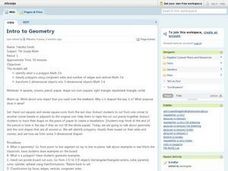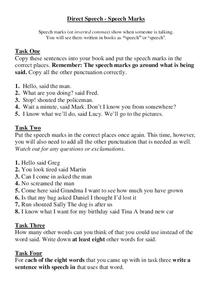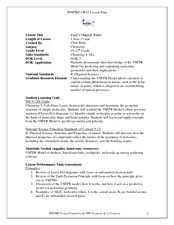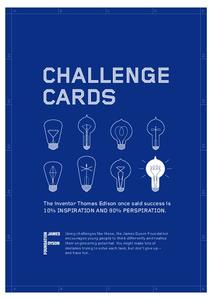Curated OER
Nets
In this cube worksheet, learners work with nets of a cube and determine which net makes an cube. Students answer 7 questions.
Curated OER
Physics: Visualization of Hydrogen Wave Functions
Students explore various methods for visualizing the results of hydrogen wave function. They observe trends using a polar plot tool and make plots for the first three energy levels of the radial wave function for hydrogen. Students apply...
Curated OER
Color and Composition for the Creative Quilter
Students explore free-motion machine quilting through three exercises. They enhance patterns, make their own patterns and stitch a realistic quilted drawing. Students create a color wheel and develop a variety of methods that enable them...
Curated OER
Intro to Geometry
Seventh graders identify a polygon and classify them using congruent sides and number of edges and vertices. Students transform two dimensional objects into three dimensional objects.
Curated OER
House Dimensions
Fourth graders measure the perimeters of several different rooms. They convert the measurements using ratios that allow them to draw the rooms to scale on paper. They draw the dimensions of a house to scale. They measure length to the...
Curated OER
Weather Review
In this weather instructional activity, learners reviews terms associated with measuring different weather phenomena plus draw examples of different types of fronts on a weather map. This instructional activity has 5 true or false, 15...
Curated OER
Joseph Holston Exhibition Lesson Plan
Students, in groups, view original artworks by Joseph Holston in a gallery space. They create a genre work of art that emphasizes the use of the artistic elements line, color, and shape.
Curated OER
Rock Identification Lab
Eighth graders compare and contrast the three different types of rock. In this earth science lesson, 8th graders classify rock samples according to their correct rock type. They design their own data collection table.
Curated OER
Prime and Composite Numbers
Sixth graders inspect prime and composite numbers. Using graph paper, they draw as many different shaped rectangles as possible. They use the dimensions of the rectangles to discuss prime and composite numbers. Students create a chart...
Curated OER
Cells, The Structural and Functional Units of Life
Students observe the general structure and organelles of plant and animal cells. Students prepare microscope slides of elodea, onion, check, and cork and identify the cells by size and shape as unicellular, multicellular, plant or animal.
Curated OER
More than Masks
Middle schoolers design their own mask using the face as the base. Using pieces of acetate, they mold the material into the shape of their face and turning it into an animal. They must draw their design and calculate the measurements...
Curated OER
Fossil Guide
Students produce a "Fossil Guide" that covers twelve fossils and includes a drawing and written description for each fossil. The written description should include such things as size, shape, and general appearance.
Curated OER
Right Angles in the Classroom
In this finding right angles worksheet, learners look around the classroom and draw any right angles they see. Students then "tick" any right angle in 6 geometric shapes.
Curated OER
Pauli's Magical Water
Students predict the shape of molecules using VSEPR theory. In this chemistry lesson, students differentiate a polar and nonpolar molecule. They discuss why water's polarity is very important.
Curated OER
Houses and the People They Shelter
Students examine different homes and shelters across cultures and time periods. In this Houses and the People They Shelter lesson, students draw conclusions about society and culture according to the features of their dwellings. Students...
James Dyson Foundation
Challenge Cards
Can you build it? Yes you can! This interactive game includes four design challenges presented on separate cards. The cards outline the challenges with limited restrictions but with an end goal in mind. The competitions include building...
Mathematics Vision Project
Geometric Figures
Logical thinking is at the forefront of this jam-packed lesson, with young mathematicians not only investigating geometric concepts but also how they "know what they know". Through each activity and worksheet, learners wrestle with...
Curated OER
Making an Angle Eater
Third graders create angle eaters where they use circles with cut outs to identify right, obtuse, and acute angles. Students complete 1 angle eater.
Curated OER
Digital Story with Math Vocab Words
Create digital stories with your class, in order to help further understand math vocabulary. You can modify this activity idea to any vocabulary lesson, whether it be for math, science, or language arts!
Curated OER
What are the Kinds of Triangles?
Fifth graders classify triangles. In this triangle lesson, 5th graders learn about the characteristics that make up a triangle. They are instructed through video, PowerPoint slides, and teacher-led demonstrations.
Curated OER
Wetland in a Pan
Seventh graders build a watershed from various materials. In this life science lesson plan, the students will be able to change the design of their watershed to see the changes in the way the water will drain. Each group will be able to...
Bowland
Design the Mascot
Explore how resizing an object affects its area. The set of lessons challenges young mathematicians to design a mascot for electronic devices. These designs undergo resizing to determine how scale factors of dilation affect area.
Arts & Humanities
Make Your Own Flower Garden
Get into art with a little instructional activity on flower parts. The class reviews basic information regarding flowers and then they use a paper mosaic technique to create visual representations of the lovely plants.
Curated OER
Repeating Patterns
Students explore growth patterns by using manipulatives such as pattern blocks, investigate growth pattern of pattern, record growth in T-chart, describe how pattern is growing, and predict number of blocks needed to extend pattern.























